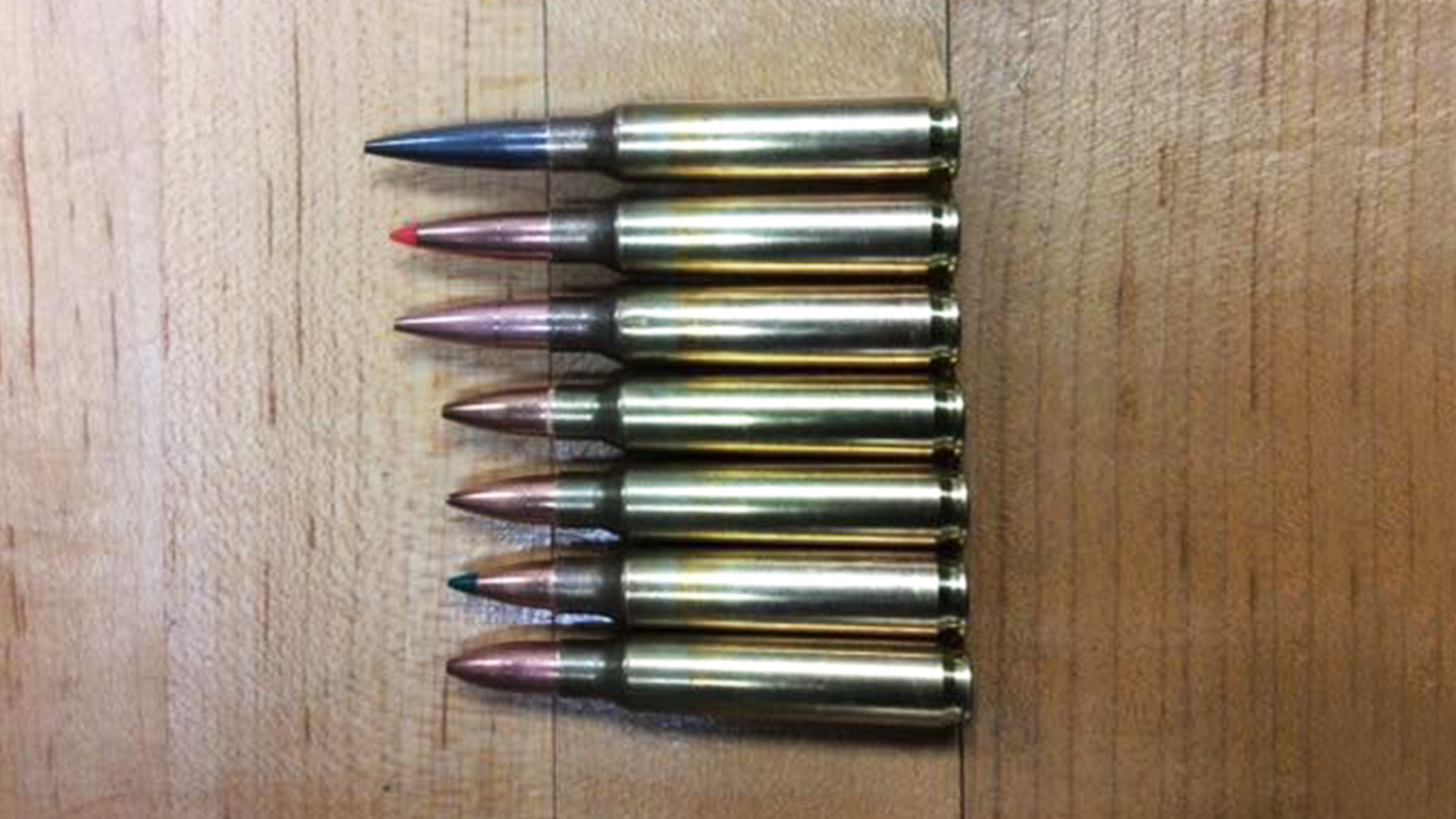
WARNING: All technical data in this publication, especially for handloading, reflect the limited experience of individuals using specific tools, products, equipment and components under specific conditions and circumstances not necessarily reported in the article and over which the National Rifle Association (NRA) has no control. The data has not otherwise been tested or verified by the NRA. The NRA, its agents, officers and employees accept no responsibility for the results obtained by persons using such data and disclaim all liability for any consequential injuries or damages.
Above: Before deciding on throat length, make dummy cartridges with the bullets you wish to use. These allow you easy comparison of relative ogive lengths and help ensure compatibility.
The previous two articles in this series on beginning handloading addressed various aspects of having a competition rifle built with a specialized chamber. Part 1 provided essential background information—readers who missed it are encouraged to read it before continuing.
In Part 2, we concluded with the subject of real-world practicality in one’s custom rifle project. Carefully consider the logistics and cost of your project before jumping in. Particularly with 5.56mm Match chambers, long-proven reamers already exist which address almost any need. Using them not only helps avoid unanticipated surprises, but saves several hundred dollars vs. the cost of a custom reamer. Rifle shooters, particularly bolt-gunners, are more apt to choose a lesser-known cartridge or even a wildcat, if they perceive a significant advantage for their purposes. The flexibility of their rifles offers more fertile fields for specialized cartridges than do most semi-autos.
Before choosing any off-beat cartridge, existing wildcat or designing your own wildcat, weigh the cost vs. any advantages. Ignore the siren song of ballistic adventure—this is the time to be brutally honest. Is the basic brass difficult to find, periodically unavailable on the market, and/or highly expensive? Can it be formed from a readily-available cartridge if needed? Will your rifle be hard to feed, down the line? Are custom dies required, or can they be made by altering existing dies at much less expense?
Is the key advantage of the cartridge under consideration heavily dependent upon certain bullets, powder or primers that may become hard or impossible to get? Active High Power and Long-Range competitors may expend a prodigious number of rounds in one active season. What will be the total cost of enough brass to support your rifle until the barrel is shot out? After that, consider other practical concerns such as, how well does it feed from a given magazine or in a given action?
Once having done the math, it becomes easier to understand why so many shooters opt for proven, long-time favorite cartridges. Brass and other components are readily available, there is no special cost for custom reamers or dies, and their performance is well-known. However, if there is a material advantage to be realized, and if one’s spouse won’t immediately begin divorce proceedings once the bill is tallied up, then one might well choose the more adventurous path. Certainly, there is much practical wisdom to be learned along the way! Moreover, many shooters derive much enjoyment from tinkering with specialized cartridges that fill their particular niche.
When discussing your chamber, one question to ask your ‘smith is what type reamer he will use. If he says “fixed pilot,” squint carefully at your choice. Fixed pilot reamers are guided at the throat (leade) by a one-size-fits-all pilot small enough to work in most any barrel the ‘smith might encounter. While they can produce good accuracy in the hands of a very competent, careful ‘smith, certain factors can also introduce an element of random chance into the outcome. High quality barrel blanks, fitting, chambering, contouring, polishing and installing sights are expensive operations. A failure here can be frustrating and waste a lot of money and time.
As precision riflemen, we want no part of luck—we want every factor carefully researched and working in our favor. Fixed-pilot reamers can easily produce chamber throats which are ragged and out-of-round. On the other hand, if your chosen ‘smith says “live pilot,” this should be taken as a good sign. Top accuracy ‘smiths lean heavily toward live pilot reamers. These allow them to select a pilot from a carefully-ground selection of various sizes, to very closely match your individual bore. This helps insure concentricity, and is one hallmark of a serious craftsman.
The first article in this series discussed optimizing the chamber throat length for one’s selection of bullets. Some reamers have the throating section integrally ground into them, while others allow the ‘smith to do the throating separately with a specialized reamer. Some might express concerns about this process possibly introducing a lack of concentricity to the throat. However, with top-quality tooling and attention to technique, this appears to be of minimal concern among talented accuracy specialists. Separate throating allows you to have your throat cut to accurately match your selection of bullets.
Should you decide to pursue this approach, it is wise to start by making several “dummy” cartridges with the bullets you wish to use. Depending on their intended purpose, these may be set at magazine length or longer, if they will be single-loaded. Measure the cartridge’s base-to-ogive lengths with a bullet comparator. This helps you easily see and calculate the relationship of the bullets to the leade. You can assess the compatibility of the bullets, adjust OAL lengths as necessary, and perhaps even select new bullets, based on your findings.
These dummy cartridges will be very helpful to your ‘smith. He will use them as a gauge to determine optimal throat length, of course. However, if he sees any glaring problems or opportunities for improvement, they will give him a chance to bring this to your attention.
SSUSA thanks the U.S. Army Marksmanship Unit for allowing the reprint of this article.


































